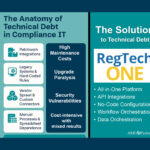
Workflow Orchestration in AML–A strategic advance
In today’s fast-evolving financial landscape, effective compliance is more than a regulatory checkbox—it’s a strategic imperative. Financial institutions and organizations involved in high-stakes financial activities are challenged daily by an ever-growing volume of data, disparate technology systems that specialize in parts of the whole, complex regulatory demands, and increasingly sophisticated financial crimes.
At the heart of a robust AML Compliance and Governance, Risk, and Compliance (GRC) strategy lies workflow orchestration, a powerful tool that brings clarity, efficiency, and resilience to AML (Anti-Money Laundering) compliance programs. This post explains why workflow orchestration is indispensable in modern AML compliance and GRC frameworks.
Understanding Workflow Orchestration
Workflow orchestration refers to the coordination and automation of complex, interrelated processes that span multiple systems and departments and integrates data from many sources. In the context of AML compliance and GRC, this involves the following:
- Integrating Disparate Data Sources: Seamlessly consolidating information from transaction systems, customer databases, external watchlists, and regulatory feeds.
- Automating Manual Processes: Reducing human error and enhancing efficiency by automating routine tasks such as data collection, transaction monitoring, and report generation.
- Ensuring Real-Time Visibility: Offering centralized dashboards and alerts that provide compliance teams with instant insights into potential risks and irregularities.
- Facilitating Regulatory Reporting: Streamlining the creation and submission of essential documentation to meet regulatory requirements promptly and accurately.
By orchestrating these elements, organizations can move from reactive to proactive compliance management—turning data chaos and siloed systems into actionable intelligence.
The imperative of Workflow Orchestration in AML Compliance
1. Enhanced Detection and Prevention of Financial Crime
Financial criminals are constantly devising new ways to exploit system vulnerabilities. Workflow orchestration empowers organizations to respond in these ways:
- Identify Anomalies in Real Time: Integrated, automated systems are better positioned to flag suspicious transactions as they occur, rather than days or weeks later.
- Correlate Data Across Systems: By unifying disparate data streams, orchestration enables the detection of complex patterns that might indicate money laundering or other illicit activities.
2. Improved Efficiency and Reduced Operational Costs
Manual, siloed processes are not only prone to error but also drain valuable resources. Workflow orchestration, in contrast, does the following:
- Streamlines Operations: Automating routine compliance tasks frees up staff to focus on higher-level strategic analysis and investigation.
- Reduces Redundancies: By creating a single source of truth for data, organizations eliminate duplicate efforts and ensure consistency across departments.
3. Strengthened Governance and Risk Management
Effective GRC is built on the foundation of clear, consistent processes. Workflow orchestration enhances GRC by:
- Providing Centralized Oversight: A unified platform allows compliance teams to monitor, manage, and report on all aspects of AML controls and risk management.
- Ensuring Accountability: Detailed logs and audit trails make it easier to trace decisions and actions back to specific processes, thereby reinforcing accountability and transparency.
4. Agility in a Dynamic Regulatory Environment
Regulations are continuously evolving, and financial institutions must adapt quickly to remain compliant. Orchestrated workflows offer improvements via core features:
- Flexibility: Modern orchestration platforms, such as AML Partners’ RegTechONE®, allow institutions to reconfigure processes swiftly in response to new regulatory requirements or emerging risks.
- Scalability: As data volumes and complexity increase, automated workflows can scale accordingly, ensuring that compliance efforts remain robust and effective.
Real-World Insights: How AML Partners leverages workflow orchestration
AML Partners, a recognized leader in the compliance technology space, exemplifies the power of workflow orchestration. Their platform, RegTechONE®, is built on the premise that effective AML compliance hinges on the ability to integrate, automate, and monitor data flows across the entire organization. The following are core features, for example:
- Automating Customer Due Diligence (CDD) Processes: The platform ensures that onboarding and ongoing monitoring are both efficient and consistent.
- Integrating Transaction Monitoring: It continuously reviews transactional data, making it easier to detect suspicious patterns in real time.
- Streamlining Regulatory Reporting: Automated reporting capabilities reduce the administrative burden and minimize the risk of errors in submissions.
AML Partners’ approach not only improves compliance performance but also provides tangible benefits in terms of risk reduction and operational efficiency—an approach that resonates across the financial services industry.
Summary
In an era where data is both abundant and essential and AML Compliance tech tools abound, workflow orchestration stands out as a transformative force in AML compliance and GRC. By integrating disparate systems, automating key processes, and providing real-time analysis, orchestration empowers organizations to not only meet regulatory demands but also to stay ahead of emerging risks. As financial institutions navigate the complexities of modern compliance, investing in robust workflow orchestration solutions will be crucial to safeguarding their operations and maintaining regulatory integrity.
For more insights on how workflow orchestration can revolutionize your compliance strategy, visit AML Partners and explore the future of AML and GRC today.


